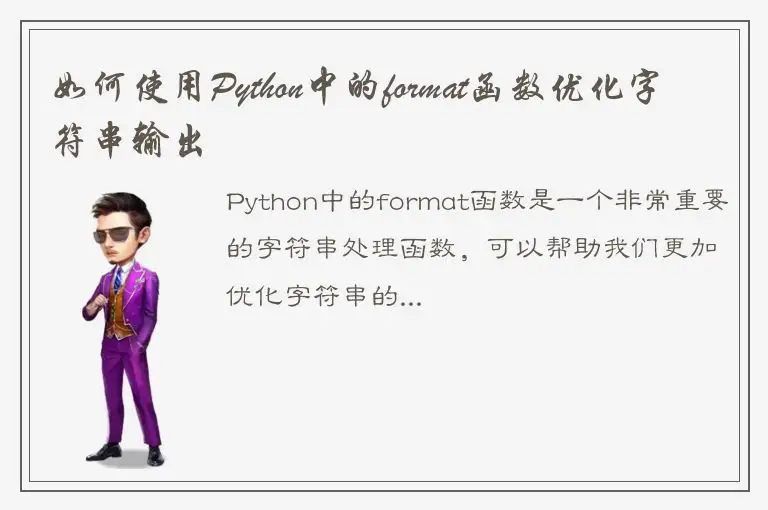Python中的format函数是一个非常重要的字符串处理函数,可以帮助我们更加优化字符串的输出。在本篇文章中,我们将深入探讨。

1. format函数的基本用法
在Python中,我们可以使用format函数来格式化我们的字符串。其基本用法如下:
``` python
"{0} is {1} years old.".format(name, age)
```
其中,大括号内的数字表示参数的位置,从0开始计数。这种方式称为位置参数。我们可以将这些位置参数替换为任何我们想要的值。
此外,我们还可以使用命名参数。命名参数以名称的形式传递参数值,并且在大括号中使用名称而不是位置来引用它们。例如:
``` python
"{name} is {age} years old.".format(name="John", age=28)
```
最后,我们还可以使用混合参数。混合参数包括位置参数和命名参数,其中位置参数首先列出,然后是命名参数。例如:
``` python
"{0} is {age} years old, and he likes {interest}.".format("John", age=28, interest="reading")
```
2. 格式化字符串
Python的format函数提供了多种格式选项,以满足我们不同的需求。下面的示例显示了最常用的一些格式选项。
2.1 字符串
如果我们想要将一些值插入到字符串中,我们可以使用s格式。这个格式选项将值转换为字符串,并将其插入到我们正在构建的字符串中。例如:
``` python
name = "John"
age = 28
print("My name is {0}, and I am {1} years old.".format(name, age))
```
这将输出:
```
My name is John, and I am 28 years old.
```
2.2 整数
当我们需要将整数插入到字符串中时,我们可以使用d格式。这个格式选项将数值转换为十进制整数,并将其插入到字符串中。例如:
``` python
age = 28
print("I am {0:d} years old.".format(age))
```
这将输出:
```
I am 28 years old.
```
当然,我们还可以指定整数的其他格式。例如,我们可以使用b格式将整数转换为二进制字符串:
``` python
age = 28
print("In binary, I am {0:b} years old.".format(age))
```
这将输出:
```
In binary, I am 11100 years old.
```
2.3 浮点数
当我们需要将浮点数插入到字符串中时,我们可以使用f格式。这个格式选项将数值转换为浮点数,并将其插入到字符串中。例如:
``` python
height = 1.75
print("I am {0:f} meters tall.".format(height))
```
这将输出:
```
I am 1.750000 meters tall.
```
我们还可以指定浮点数的其他格式,例如保留小数点后一定精度的方式。例如,我们可以使用.2f格式将浮点数保留到小数点后2位:
``` python
height = 1.75
print("I am {0:.2f} meters tall.".format(height))
```
这将输出:
```
I am 1.75 meters tall.
```
2.4 日期和时间
Python的format函数还提供了一些格式选项,用于格式化日期和时间。下面的示例显示了其中的一些:
选项 | 含义
---|---
%Y | 4位数的年份
%y | 2位数的年份
%m | 2位数的月份(01-12)
%d | 2位数的日(01-31)
%H | 24小时制小时数(00-23)
%I | 12小时制小时数(01-12)
%p | AM或PM
%M | 2位数的分钟数(00-59)
%S | 2位数的秒数(00-59)
例如,我们可以使用以下方式将当前日期和时间格式化为字符串:
``` python
import datetime
now = datetime.datetime.now()
print("Today is {0:%Y-%m-%d %H:%M:%S}.".format(now))
```
这将输出:
```
Today is 2021-04-19 12:30:00.
```
3. 宽度,对齐和填充
我们可以使用格式选项来控制插入值的宽度,对齐和填充。下面的示例显示了其中的一些:
选项 | 含义
---|---
:> | 将值向右对齐
:< | 将值向左对齐
:^ | 居中
:|< | 以竖线(|)填充左侧
:|> | 以竖线(|)填充右侧
:|= | 以竖线(|)填充中心
:0> | 以0填充右侧
:x< | 用x填充左侧
:-^ | 用横线(-)居中
例如,我们可以使用以下方式将一个值向右对齐,宽度为10个字符,并使用0进行填充:
``` python
value = 12
print("{0:0>10}".format(value))
```
这将输出:
```
0000000012
```
我们还可以使用以下方式将值向左对齐,宽度为10个字符,并使用空格进行填充:
``` python
value = 12
print("{0:<10}".format(value))
```
这将输出:
```
12
```
4. format函数格式嵌套
我们可以将format函数的结果嵌套到较长的字符串中。这非常有用,因为它允许我们在格式化字符串时组合多个值。例如:
``` python
name = "John"
age = 28
print("My name is {0}, and I am {1} years old. {0} is a nice person.".format(name, age))
```
这将输出:
```
My name is John, and I am 28 years old. John is a nice person.
```
我们还可以在format函数中嵌套其他format函数,以便在一个字符串中处理多个字符串。
``` python
name = "John"
age = 28
print("{0} is {1} years old. {0} likes {2}.".format(name.capitalize(), age, "reading and running".upper()))
```
这将输出:
```
John is 28 years old. John likes READING AND RUNNING.
```
5. 总结
在本篇文章中,我们深度探讨了。我们学习了format函数的基本用法,以及如何使用不同的格式选项来格式化字符串、日期和时间。我们还学习了如何使用format函数的宽度,对齐和填充选项,以控制格式化输出的外观。最后,我们还介绍了如何嵌套format函数以在字符串中插入多个值。这将使您能够更好地控制字符串的输出和外观,更有效地进行文本处理。




 QQ客服专员
QQ客服专员 电话客服专员
电话客服专员